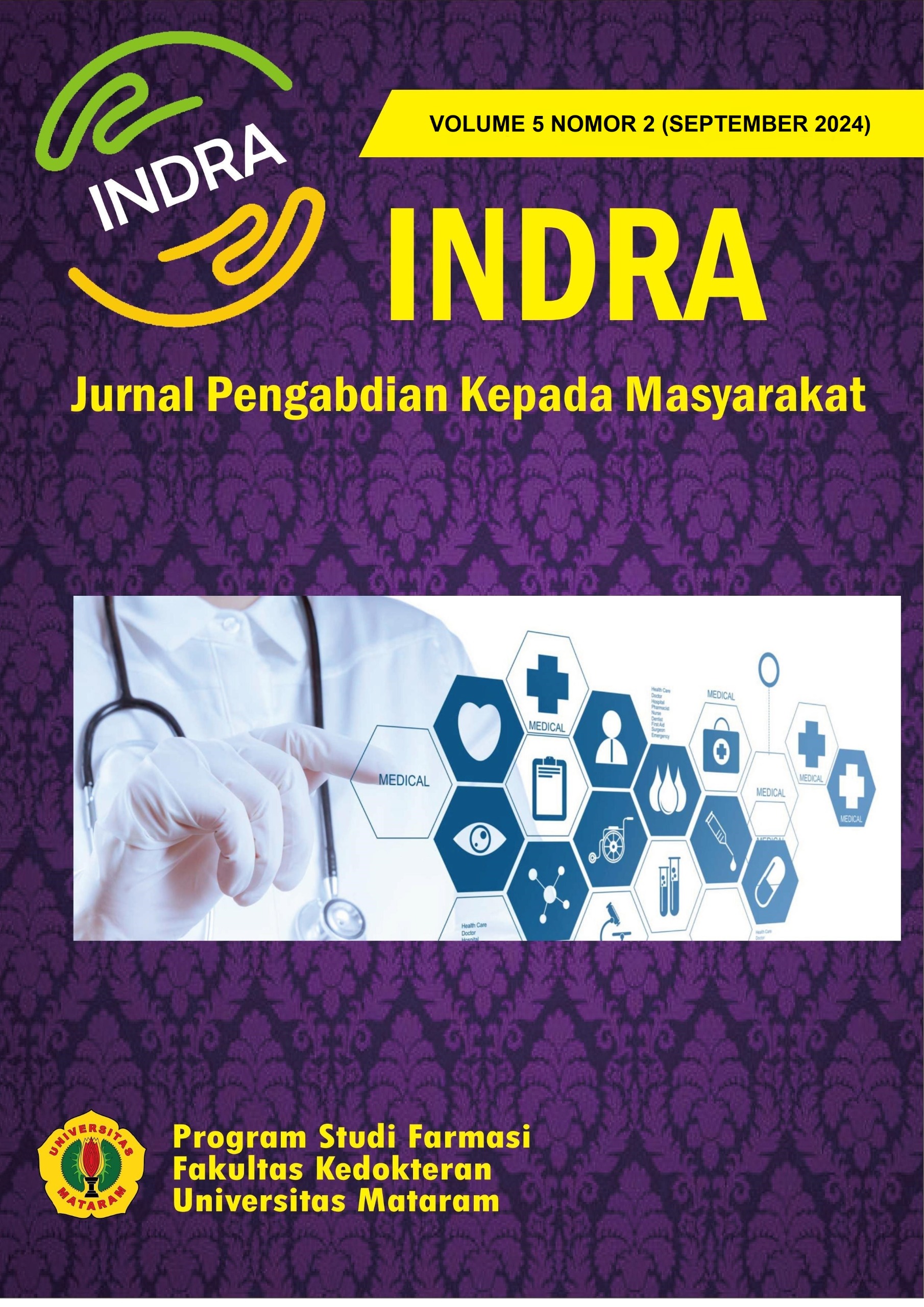Pelatihan pembuatan minuman probiotik fermentasi dari limbah kulit nanas (Ananas comosus L.) di Desa Seruawan
DOI:
10.29303/indra.v5i2.376Published:
2024-09-30Downloads
Abstract
Pineapple skin is an ingredient that can be processed into a probiotic drink. The biggest component of pineapple peel waste besides water is carbohydrates. Pineapple skin can be a good substrate as a source of microbial growth. Pineapple skin can reach 47% of the total fruit and has a chemical composition of 87.80% water, 8.60% sugar and 1.35% reducing sugar. The potential chemical content of pineapple skin has encouraged many researchers to create fermented prebiotic drink products. The ingredients used in making pineapple peel fermented probiotic drinks include: pineapple fruit, fermented yeast, water, palm sugar, cinnamon and granulated sugar. This community service activity was carried out with the aim of educating the public about how to make pineapple peel prebiotic drinks for household scale. There is a need for training in making fermented prebiotic drinks from pineapple peel in local communities. This training will be carried out for the community in Seruawan village, Seram Island, Maluku.
Keywords:
Training, Probiotics, Pineapple Skin, FermentationReferences
Behera, S. S., Ray, R. C., & Zdolec, N. (2021). Lactobacillus Plantarum: An Emerging Probiotic and a Versatile Starter Culture for Fermented Foods. Food Bioscience, 36, 100651.
Bustos, M. C., Rogé, A. D., & Samman, N. C. (2018). Probiotic Fermented Fruit Juices: Health Benefits and Nutritional Properties. Food Reviews International, 34(6), 557-572.
Fardiaz, S., Cahyono, R., & Kusumaningrum, H.D. (1996). Produksi dan Aktivitas Antibakteri Minuman Sehat Kaya Vitamin B12 Hasil Fermentasi Laktat dari Sari Wortel. Jurnal Ilmu dan Teknologi Pangan. 1(2): 25-30.
Hujjatusnaini, N., Amin, A.M., Atnelya, H.F., Robiyansyah, P.M., Guria, W.A., Husna, N., Annisa, N., & Ramlan, C. (2022). Inovasi Minuman Tepache Berbahan Baku Kulit Nanas (Ananas comosus L.) Merr.) Tersuplementasi Probiotik Lactobacillus casei. Jurnal Teknologi Pangan dan Gizi, Vol.21 (1): 47-54. DOI: https://doi.org/10.33508/jtpg.v21i1.3568
Hossain, M. D., & Iqbal, A. (2014). Production and Characterization of Probiotic Beverage from Pineapple Waste. Journal of Nutrition & Food Sciences, 4(3), 1000282.
Kabupaten Seram Bagian Barat dalam Angka Tahun (2023). BPS Kabupaten SBB.
Kechagia, M, Basoulis D, Konstantopoulou S, Dimitriadi D, Gyftopoulou K, Skarmoutsou, N., & Fakiri, E.M. (2013). Health Benefits of Probiotic: a review. Journal of ISRN Nutrition.
Liu, S., Ren, Y., Wei, Z., Zhang, J., & Zhang, X. (2020). Development of Fermented Beverages from Pineapple Peel by Mixed Yeast Fermentation. Food Science and Technology International, 26(1), 41-49.
Mappa, M.R., Kuna, M.R., & Akbar, H. (2021). Pemanfaatan Nanas (Ananas comosus L.) Sebagai Antioksidan Untuk Meningkatkan Imunitas Tubuh di Era Pandemi Covid 19. Community Engagement and Emergence Journal (CEEJ).
Novia, D., Mardhiyetti, M., Yatmanelli, Y., Susanty, H., Putra, A.A., Sriagtula, R., & Sandra, A. (2022). Pemanfaatan Mol Kulit Nanas Dalam Pembuatan Pupuk Organik Kotoran Sapi di Sipujuk Farm. RAMBIDEUN: Jurnal Pengabdian Kepada Masyarakat.
Nurainy., Fibra., Rizal, S., & Marniza. (2015). Pemanfaatan Kulit Nanas pada Pembuatan Minuman Probiotik dengan Jenis Bakteri Asam Laktat Berbeda. Seminar Nasional Sains & Teknologi VI. Lampung: Universitas Lampung.
Ramadhan, W., Islami, D., Iballa, B.D., Oktariani, E., amin, M., & Lestari, V.D. (2024). Uji Aktivitas Antibakteri Nanoemulsi Ekstrak Kulit Nanas (Ananas Comosus L. Merr). JFARM - Jurnal Farmasi, vol 2, No 1. https://doi.org/10.58794/jfarm.v2i1.653.
Sagita, C., Andini, D.S., Lubis, F.E.S., Ramadhani, S., Ramdhani, W., & Daulay, R.A. (2023). Pembuatan Minuman Probiotik Dari Limbah Kulit Nanas (Tepache). Tarbiatuna: Journal of Islamic Education Studies, vol 3, No 2: 205 -210.
Serang, M.R. (2017). Mapping Desa Terkait Indeks Pembangunan Manusia Di Kecamatan Kairatu dan Kairatu Barat. Vol XI, No.1 Jurnal Cita Ekonomika, Jurnal Ekonomi. DOI: https://doi.org/10.51125/citaekonomika.v11i1.2629
Swain, M. R., Anandharaj, M., Ray, R. C., & Rani, R. P. (2014). Fermented Fruits and Vegetables of Asia: A Potential Source of Probiotics. Biotechnology Research International, 250424. doi: 10.1155/2014/250424.
License
Copyright (c) 2024 The Author(s)

This work is licensed under a Creative Commons Attribution 4.0 International License.











